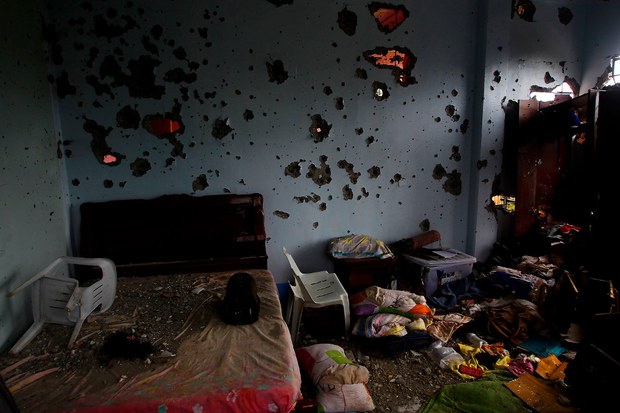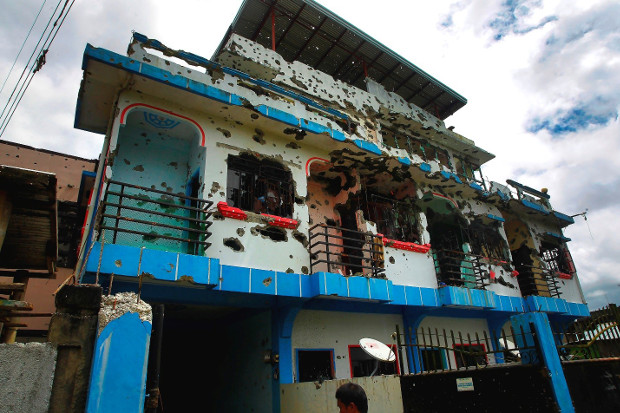Philippines: BenarNews Visits House Where Marawi Battle Began
2017.10.30
Marawi, Philippines
 A bedroom in the four-story apartment rented by militant leader Isnilon Hapilon in the southern Philippine city of Marawi shows signs of a vicious May 23 firefight, Oct. 30, 2017.
A bedroom in the four-story apartment rented by militant leader Isnilon Hapilon in the southern Philippine city of Marawi shows signs of a vicious May 23 firefight, Oct. 30, 2017.
Islamic books, hundreds of bullet cartridges and toy guns littered what was left of ground-zero of a five-month battle that killed more than 1,200 people and drew the world’s attention to a regional alliance of Southeast Asian and foreign militants in the southern Philippines.
On Monday, reporters and residents viewed the bullet-riddled four-story house in Marawi, where Isnilon Hapilon, the Filipino leader of the Islamic State (IS) branch in Southeast Asia, gave orders to his extremist forces until May 23, when government troops encountered an unexpected number of militants during a bungled attempt to arrest him.
The apartment in a quiet alley of Marawi city was where the military recovered a video showing Hapilon and other militant leaders, including Malaysia’s most-wanted terrorist, Mahmud Ahmad, planning an attack that would stoke fears that the Islamic State was trying to gain a foothold in the region.
The militants intended to show IS leaders the video as propaganda material if they succeeded in capturing Marawi as planned, military chief Gen. Eduardo Año told reporters in June.
“The grand plan of this [group] is actually, in time for the first day of Ramadan, they will seize the whole of Marawi and proclaim an Islamic caliphate just like what happened in Mosul when [Abu Bakr] al-Baghdadi occupied Mosul in June 2014,” Año said.
But the military disrupted the plan when troops raided Hapilon’s lair.
“They were not able to fully deploy all their forces,” Año said. “Supposedly more terrorists would join, but because of what happened, when we raided the safe house on May 23, where we got also the copies of the videos, it was all aborted.”
Well-trained snipers, including fighters from Indonesia, Malaysia and Arab states, fanned out in the city’s business district, occupied high-rise buildings and pinned down troops, who eventually relied on daily bombings from Air Force fighter jets.
The fighting killed almost 1,000 militants, 165 soldiers and police and 47 civilians.
The clashes were set off when soldiers and police moved to arrest Hapilon, who was on FBI’s most-wanted list with a reward of up to $5 million on his head.
Officials later acknowledged they were caught unaware that Hapilon, the recognized “emir” of IS in the region, had prepared his forces.
“The troops were surprised when they wanted to arrest Hapilon, because they initially thought there weren’t too many armed men inside the house,” Defense Secretary Delfin Lorenza told reporters earlier. “When they moved closer to the house, it turned out there were other terrorists in the area.”
On Monday, BenarNews reporters joined residents who were allowed access to Marawi’s Basak Malutlut neighborhood as they surveyed the damage after officials announced an end to the battle last week.
About 4,000 people were allowed to return to their homes on Sunday, six days after soldiers killed the last remaining militants.
The sound of birds
Hapilon’s rented apartment has remained abandoned, with the chirping of birds offering the only sign of life in an area where, the military says, the fate of Marawi was decided.
Bandoliers, thousands of ammunition casings, pocket-size copies of the Quran, discarded fatigue uniforms, toy guns and children’s shoes were scattered inside the rooms in the apartment occupied by Hapilon, a commander of the Abu Sayyaf who was killed two weeks ago.
Muzzle-blasts from rifles blackened the freshly painted walls that were pockmarked with bullets, providing a reminder that the rebels who occupied it had enough firepower to withstand a sustained military assault.
A member of the police special-action force unit who declined to be identified told BenarNews on Monday that he was holed up just two houses from the apartment. Hapilon had slipped in and out of the apartment unnoticed.
“I really didn’t have any idea that he was there. When the fighting erupted, I was even trapped for two days before I was able to get out,” he said.
Hapilon’s wife and 6-year-old son were among the first fatalities when fighting erupted, according to Amenola Gandaw, 52, a village councilman. BenarNews could not independently verify his claim.
Gandaw, whose house fronted the apartment, said Hapilon apparently stayed in two units.
“There were a lot of people coming in and out in those two units and we had no idea that he was there,” Gandaw said.
Zia Alonto Adiong, spokesman for the provincial crisis management committee, said the local government was at a loss on what to do with the structure. There were plans to leave it in its ruined state or restore it to build a museum.
But Col. Romeo Brawner Jr., deputy commander of Joint Task Group Ranao, said the owner of the apartment, a government employee who worked out of town, would be allowed to reclaim the building after police and troops finished their investigation.
“The investigation will be handled by police. But we will ensure their rights will not be violated,” Brawner said.
Superintendent Ebra Moxir, the city’s new police chief, said the apartment owner, whom he declined to identify, already showed up and told investigators he had no idea his place would be used to launch the region’s deadliest attack in years.
“They told our investigators they have no idea Hapilon was there. I advised them also to clear their names with the military,” he said.

Foreign governments to help rebuild Marawi
With the Philippine government declaring fighting over on Oct. 23 – five months to the day the battle began – the United States, the country’s main defense ally, has said it stands ready to help the Philippines rebuild Marawi’s city center, which was largely destroyed by bombing by the military.
On Monday, Japanese Prime Minster Shinzo Abe also pledged to deliver nearly $9 billion in aid to the Philippines to rebuild battle-damaged areas of Marawi and improve infrastructure throughout the country.
But there have been reports of looting allegedly committed by both sides during the fighting, and President Rodrigo Duterte has encouraged Marawi residents who wanted to file a criminal complaint to do so.
“It’s well within their right to do that,” Duterte said late Sunday before leaving for Japan for an official two-day visit.
“I declared martial law to answer the challenges of the moment and I take full responsibility. That’s on me,” he said. “I hold myself solely responsible.”







